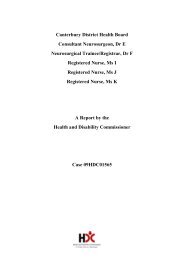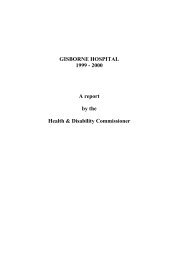Download the pdf version of this decision. - Health and Disability ...
Download the pdf version of this decision. - Health and Disability ...
Download the pdf version of this decision. - Health and Disability ...
You also want an ePaper? Increase the reach of your titles
YUMPU automatically turns print PDFs into web optimized ePapers that Google loves.
Opinion/05HDC16711<br />
requires providers to provide consumers with full information tailored to <strong>the</strong>ir<br />
individual circumstances. In circumstances where <strong>the</strong> baby is in a good position <strong>and</strong><br />
<strong>the</strong> labour is progressing well, <strong>the</strong> labouring mo<strong>the</strong>r would expect to be reassured<br />
about that progress, <strong>and</strong> <strong>the</strong>re would be little need to discuss any alternatives to a<br />
vaginal delivery. However, where any difficulties arise, <strong>the</strong> consumer should be kept<br />
appraised <strong>of</strong> <strong>the</strong>ir significance, <strong>and</strong> all options fully explored before <strong>decision</strong>s are<br />
made.<br />
Given <strong>the</strong> baby’s position, <strong>the</strong> lack <strong>of</strong> progress, <strong>and</strong> Mrs A’s anxiety about her labour,<br />
a reasonable consumer in her situation would expect to be told <strong>of</strong> <strong>the</strong> risks, side<br />
effects <strong>and</strong> benefits <strong>of</strong> continuing with an induced labour, <strong>and</strong> <strong>the</strong> relative risks <strong>and</strong><br />
benefits <strong>of</strong> any alternative, which in <strong>this</strong> case was to proceed to Caesarean section.<br />
Dr B took <strong>the</strong> view that <strong>this</strong> was a fairly routine labour <strong>and</strong> advised me that maternal<br />
consent was obtained at every stage. In response to my provisional opinion, Dr B<br />
stated that she discussed <strong>the</strong> option <strong>of</strong> a Caesarean section throughout <strong>the</strong> first stage<br />
<strong>of</strong> labour. However, <strong>the</strong> notes do not record any discussions about options. Mrs A<br />
advised that she was not given any alternative to continuing with <strong>the</strong> induced labour,<br />
<strong>and</strong> that <strong>the</strong> option <strong>of</strong> Caesarean section was not discussed.<br />
In my view, <strong>the</strong>re were two occasions where Dr B did not provide Mrs A with<br />
sufficient information to allow her to consent to <strong>the</strong> <strong>decision</strong>s being made about her<br />
care. The first was on 10 February 2001 when Caesarean section was not <strong>of</strong>fered as a<br />
reasonable option when Mrs A’s membranes had ruptured <strong>and</strong> contractions had not<br />
commenced. The second was during <strong>the</strong> afternoon <strong>of</strong> 11 February 2001 when it<br />
became apparent that <strong>the</strong> labour was not progressing <strong>and</strong> Dr B decided to increase <strong>the</strong><br />
Syntocinon infusion without discussing <strong>the</strong> risks <strong>and</strong> alternatives with Mrs A. This<br />
lack <strong>of</strong> consultation at two key points meant that Mrs A was not sufficiently informed<br />
to be able to make <strong>decision</strong>s about her care, <strong>and</strong> constitutes a breach <strong>of</strong> Right 6(1) <strong>of</strong><br />
<strong>the</strong> Code.<br />
Interpretation <strong>of</strong> <strong>the</strong> CTG tracings<br />
Under Right 4(1) <strong>of</strong> <strong>the</strong> Code, every consumer has <strong>the</strong> right to have services provided<br />
with reasonable care <strong>and</strong> skill. In <strong>the</strong> context <strong>of</strong> providing obstetric services <strong>and</strong><br />
managing a woman’s labour, <strong>this</strong> includes <strong>the</strong> reasonable interpretation <strong>of</strong> clinical<br />
information such as CTG tracings <strong>and</strong> recognising when fur<strong>the</strong>r action is required.<br />
Mrs A’s labour was monitored continuously throughout <strong>the</strong> first stage <strong>of</strong> labour <strong>and</strong><br />
most <strong>of</strong> <strong>the</strong> second stage. When Mrs A was transferred to <strong>the</strong> delivery <strong>the</strong>atre, a CTG<br />
machine was temporarily unavailable.<br />
Dr B has described <strong>the</strong> CTG tracings as not showing any abnormalities, persistent<br />
decelerations, or signs <strong>of</strong> fetal asphyxia. She noted on <strong>the</strong> clinical record at 1730 that<br />
<strong>the</strong> CTG was “OK”. This, however, is inconsistent with Mrs A’s discharge summary,<br />
which records that <strong>the</strong> CTG was abnormal.<br />
19 September 2006 19<br />
Names have been removed to protect privacy. Identifying letters are assigned in alphabetical order<br />
<strong>and</strong> bear no relationship to <strong>the</strong> person’s actual name.
















